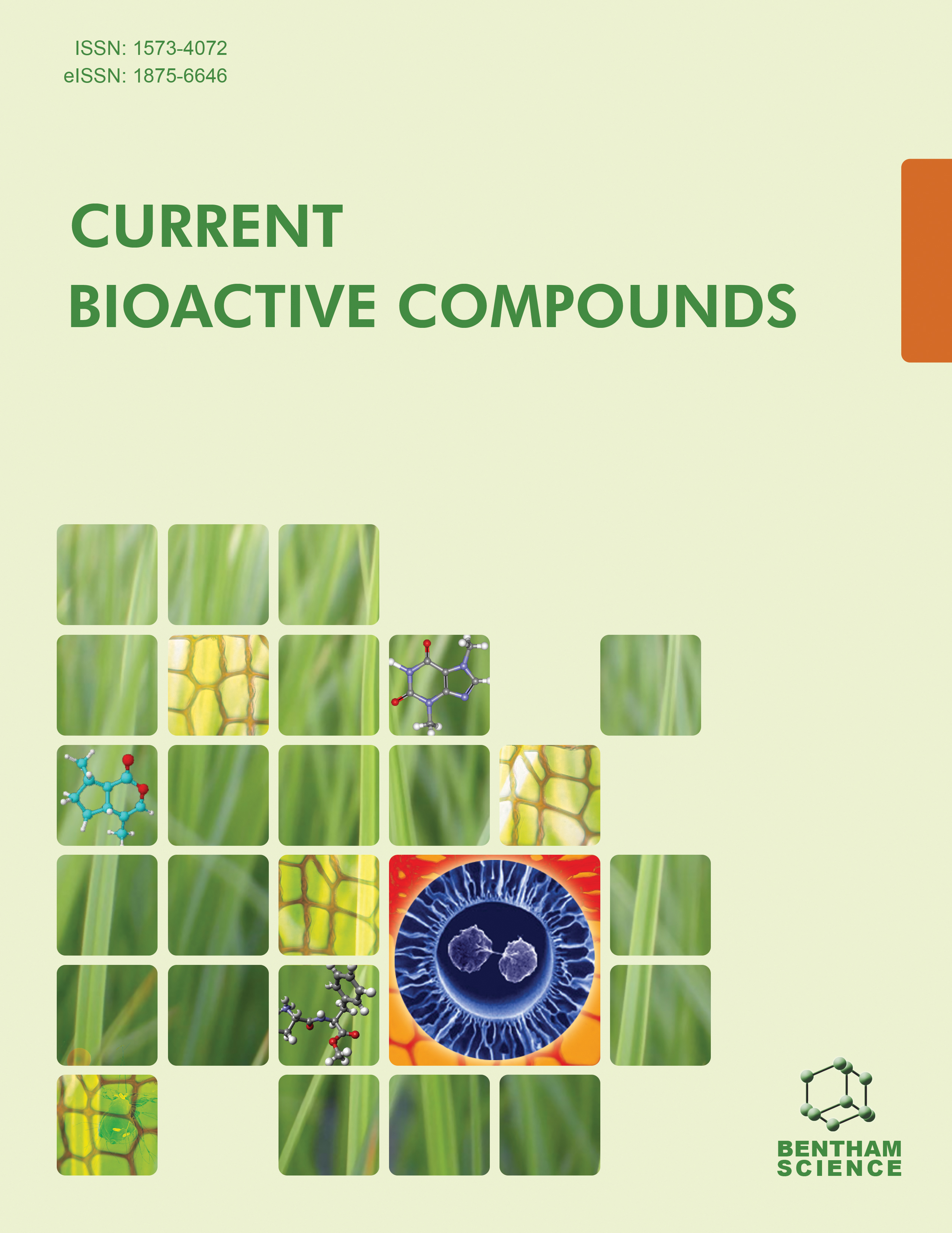- Home
- A-Z Publications
- Current Bioactive Compounds
- Previous Issues
- Volume 19, Issue 1, 2023
Current Bioactive Compounds - Volume 19, Issue 1, 2023
Volume 19, Issue 1, 2023
-
-
Effect of Estradiol on Chondrocytes in the Active Stage of Collagenase- Induced Osteoarthritis
More LessAuthors: Petya Ganova, Lyudmila Belenska-Todorova and Nina IvanovskaAim: The aim of the present study is to examine the effect of estradiol on chondrocyte inflammatory potential and apoptosis in a mouse model of osteoarthritis (OA). Background: OA is a degenerative joint disease related to articular cartilage disintegration, together with substantial changes in the subchondral bone. Estradiol (ED) is considered to be an important player in maintaining bone homeostasis. Increasing evidence supp Read More
-
-
-
Phenolic Compounds and Antioxidant and Antimicrobial Activities of Pulicaria Odora Extract
More LessAuthors: Karima Saidani, Naima Touati, Hafida Merzouk, Halim Boussaa, Fatiha Bedjou and B. D. OomahBackground: The Pulicaria genus (Asteraceae family) plays a remarkable role in the development of drugs used in modern medicine. Leaf extracts of Pulicaria odora harvested in Bejaia were evaluated for their antioxidant and antimicrobial activities. Methods: HCl method at three different wavelengths (280, 320, and 360 nm) was carried out for total phenolic content and characterized by ultra-performance liquid chromato Read More
-
-
-
Phenolic Content and Scavenging Activity in Moringa oleifera Lam. with Two Types of Leaf Color
More LessAuthors: Silvia Radice, Federico Gómez Castro, Miriam E. Arena and Edgardo GiordaniBackground: Mostly, Moringa plants (Moringa oleifera Lam.) are commercially propagated by seeds; however, there are some plantations from stem cuttings. Thus, seedling populations show a high morphological diversity level due to segregation. In particular, differences in leaf color can be commonly observed. This work aimed to characterize leaf color from different moringa plants and relate it to phenolic leaf content, incl Read More
-
-
-
In Vitro Evaluation of Cytotoxic Activity of Algerian propolis against Human Breast Adenocarcinoma (MDA-MB-231) Cells and Investigation of its Potential Mechanism of Action
More LessAuthors: Farid Nasirli, Amina Daikh, Nazime M. Doğan, Sevki Arslan, Doğukan Mutlu and Narimane SegueniBackground: Breast cancer is a major cause of death in women worldwide. Propolis antitumor activity has become the subject of growing research related to breast cancer. Algerian propolis is being studied for its antitumor activity on several cell lines. However, little is known about its cytotoxic activity on the human breast adenocarcinoma cell line. Objective: The present study aimed to investigate the cytotoxic effect of Algerian Read More
-
-
-
Phenolic Compounds of Fig (Ficus carica L.) Leaves: Optimization of Extraction by Response Surface Methodology and UPLC-MS Phytochemical Characterization
More LessAuthors: Sonia Yahiaoui, Djamel E. Kati, Makhlouf Chaalal, Amar Otmani, Nadir Bettache and Mostapha Bachir-beyBackground: This study is based on ethnobotanical observation and traditional medicinal utilization of fig (Ficus carica L.) by southwest Asian and Mediterranean populations. Objective: Considering phenolics among the highly bioactive compounds for their numerous therapeutic applications, this investigation's first goal is to optimize their recovery by using Response Surface Methodology (RSM). Methods: Prior to RSM, the singl Read More
-
-
-
Antibacterial, Anti-Inflammatory, and Antidiabetic Studies of the Amines Isolated from the Philippine Marine Sponge Desmacella sp
More LessAims: The study aimed to isolate and elucidate the structure of pure compounds from the polar extract of the marine sponge Desmacella sp. and explore their therapeutic potential. Background: Only a few marine organisms and their associated microorganisms collected from various parts of the Philippines have been documented and investigated in terms of their potential as sources of bioactive secondary metabolites. The s Read More
-
-
-
Ramalin: A Multi-Mechanistic Lichen Metabolite of Pharmacological Importance
More LessAuthors: Deepti Katiyar, Priya Bansal, Abhishek Kumar and Surya PrakashBackground: Ramalin (γ-glutamyl-N'-(2-hydroxyphenyl) hydrazide), a nitrogencontaining lichen secondary metabolite, was isolated from Ramalina terebrata, an Antarctic lichen. Since then, it has attracted several researchers, thus leading to various research investigations exploring the pharmacological potential of Ramalin. Methods: The bibliographic databases were explored for the peer-reviewed research related to th Read More
-
-
-
Modified Drug Delivery Systems for Veterinary Use: Pharmaceutical Development and Applications
More LessScientific research in the field of veterinary pharmacology has provided new opportunities for the development of modified release dosage forms, with the aim to improve therapeutic efficacy and reduce animal stress. The formulation of classical drug molecules with advanced biomaterials has become a new approach to increasing drug bioavailability and improving the therapeutic outcome. The main reasons for the developme Read More
-
-
-
Male Reproductive Dysfunction and Pharmacological Action of Curcumin: A Concise Review
More LessAuthors: Damilare E. Rotimi, Omowumi T. Kayode and Oluyomi S. AdeyemiBackground: Male reproductive dysfunctions are the results of the malfunctioning of one or more cellular components due to several factors, including exposure to heavy metals, reactive oxygen species, smoking and alcohol, genital infection, lifestyle, hormonal disorders, and unhealthy diet. However, it has been widely reported that curcumin possesses pharmacological potential, which could ameliorate the effects of the Read More
-
Volumes & issues
-
Volume 21 (2025)
-
Volume 20 (2024)
-
Volume 19 (2023)
-
Volume 18 (2022)
-
Volume 17 (2021)
-
Volume 16 (2020)
-
Volume 15 (2019)
-
Volume 14 (2018)
-
Volume 13 (2017)
-
Volume 12 (2016)
-
Volume 11 (2015)
-
Volume 10 (2014)
-
Volume 9 (2013)
-
Volume 8 (2012)
-
Volume 7 (2011)
-
Volume 6 (2010)
-
Volume 5 (2009)
-
Volume 4 (2008)
-
Volume 3 (2007)
-
Volume 2 (2006)
-
Volume 1 (2005)
Most Read This Month
Article
content/journals/cbc
Journal
10
5
false
en

Most Cited Most Cited RSS feed
-
-
Podophyllotoxin: Current Perspectives
Authors: Ying Qian Liu, Liu Yang and Xuan Tian
-
- More Less

